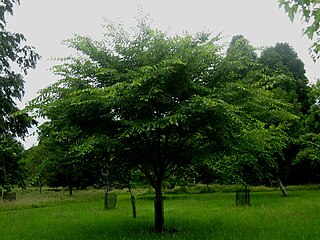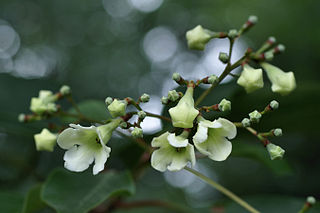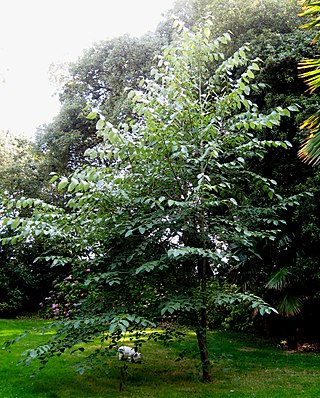
Syringa is a genus of 12 currently recognized species of flowering woody plants in the olive family or Oleaceae called lilacs. These lilacs are native to woodland and scrub from southeastern Europe to eastern Asia, and widely and commonly cultivated in temperate areas elsewhere.

Clematis is a genus of about 380 species within the buttercup family, Ranunculaceae. Their garden hybrids and cultivars have been popular among gardeners, beginning with Clematis 'Jackmanii', a garden standby since 1862; more cultivars are being produced constantly. They are mainly of Chinese and Japanese origin. Most species are known as clematis in English, while some are also known as traveller's joy, a name invented for the sole British native, C. vitalba, by the herbalist John Gerard; virgin's bower for C. terniflora, C. virginiana, and C. viticella; old man's beard, applied to several with prominent seedheads; leather flower for those with fleshy petals; or vase vine for the North American Clematis viorna.
Hidden Lake Gardens colloquially known as Hidden Lake 755 acres (3.06 km2), is a botanical garden and an arboretum operated by Michigan State University situated in the Irish Hills of southeast Michigan. The Gardens are known for their large collection of native and nonnative trees, shrubs and flowers. HLG was given to Michigan State University by Harry Fee in 1945. Today it is visited by nearly 45,000 people annually. Hidden Lake Gardens mission is to "preserve and enhance the natural beauty of the gardens and to display plants for the inspiration and education of the public".

Lasdon Park and Arboretum is a public park containing gardens and an arboretum. It is located on New York State Route 35, Somers, New York, and open to the public daily without charge.

Ulmus pumila, the Siberian elm, is a tree native to Asia. It is also known as the Asiatic elm and dwarf elm, but sometimes miscalled the 'Chinese Elm'. U. pumila has been widely cultivated throughout Asia, North America, Argentina, and southern Europe, becoming naturalized in many places, notably across much of the United States.

Ulmus davidiana var. japonica, the Japanese elm, is one of the larger and more graceful Asiatic elms, endemic to much of continental northeast Asia and Japan, where it grows in swamp forest on young alluvial soils, although much of this habitat has now been lost to intensive rice cultivation.

The Sir Harold Hillier Gardens is an arboretum comprising 72 hectares accommodating over 42,000 trees and shrubs in about 12,000 taxa, notably a collection of oaks, camellia, magnolia and rhododendron.

Augustine Henry was a British-born Irish plantsman and sinologist. He is best known for sending over 15,000 dry specimens and seeds and 500 plant samples to Kew Gardens in the United Kingdom. By 1930, he was a recognised authority and was honoured with society membership in Belgium, Czechoslovakia, Finland, France, and Poland. In 1929 the Botanical Institute of Peking dedicated to him the second volume of Icones plantarum Sinicarum, a collection of plant drawings. In 1935, John William Besant was to write: 'The wealth of beautiful trees and flowering shrubs which adorn gardens in all temperate parts of the world today is due in a great measure to the pioneer work of the late Professor Henry'.

Ulmus laciniata(Trautv.) Mayr, known variously as the Manchurian, cut-leaf, or lobed elm, is a deciduous tree native to the humid ravine forests of Japan, Korea, northern China, eastern Siberia and Sakhalin, growing alongside Cercidiphyllum japonicum, Aesculus turbinata, and Pterocarya rhoifolia, at elevations of 700–2200 m, though sometimes lower in more northern latitudes, notably in Hokkaido.

Ulmus davidiana, also known as the David elm, or Father David elm, is a small deciduous tree widely distributed across China, Mongolia, Korea, Siberia, and Japan, where it is found in wetlands along streams at elevations of 2000–2300 m (6,500–7,500 ft). The tree was first described in 1873 from the hills north of Beijing, China.

The Field Elm cultivar Ulmus minor 'Viminalis Aurea', probably a "golden" form of Ulmus minor 'Viminalis', was raised before 1866 by Egide Rosseels of Louvain, who was known to have supplied 'Viminalis'.

The Siberian Elm cultivar Ulmus pumila 'Pendula' is from northern China, where it is known as Lung chao yü shu. It was classified by Frank Meyer in Fengtai in 1908, and introduced to the United States by him from the Peking Botanical Garden as Weeping Chinese Elm. The USDA plant inventory record (1916) noted that it was a "rare variety even in China". It was confirmed as an U. pumila cultivar by Krüssmann (1962).

Heptacodium miconioides, the seven-son flower, is a species of flowering plant. It is the sole species in the monotypic genus Heptacodium, of the honeysuckle family Caprifoliaceae. The common name "seven-son flower" is a direct translation of the Standard Chinese name 七子花 qī zi huā.

Ulmus parvifolia, commonly known as the Chinese elm or lacebark elm, is a species native to eastern Asia, including China, India, Japan, Korea, and Vietnam. It has been described as "one of the most splendid elms, having the poise of a graceful Nothofagus".

Fargesia murielae, the umbrella bamboo, is a species of flowering plant in the family Poaceae. It is a large, clump-forming evergreen bamboo, closely resembling Fargesia nitida in the same genus, but with yellow canes.

Tilia mongolicaMaxim., commonly known as Mongolian lime, is a tree native to mountains of the northern China, growing up to elevations of 1200–2200 m.

Emmenopterys is a genus of flowering plants in the family Rubiaceae. The genus is found in China, Burma, Thailand, and Vietnam.

Tilia tuan is a species of flowering plant found in forests at elevations of 1200–2400 m in the central Chinese provinces of Guangxi, Guizhou, Hubei, Hunan, Jiangsu, Jiangsu, Jiangxi, Sichuan, Yunnan, and Zhejiang. The species has long been regarded as the most variable lime within China, acquiring numerous synonyms; three varieties are currently recognized. The tree was first described by Henry who discovered it in 1888.

William A. McNamara is an American horticulturist and expert in the field of plant conservation and the flora of Asia. Now retired, he was the President and Executive Director of Quarryhill Botanical Garden, a 25-acre wild woodland garden in Northern California's Sonoma Valley featuring wild-sourced plants from temperate East Asia. In 2017, he and Quarryhill Botanical Garden celebrated their 30th Anniversary. He retired from the Garden in October of 2019.

Jelena de Belder-Kovačič was a Slovenian-Belgian botanist and horticulturist, who worked extensively on the taxonomy and preservation of plant specimens, gaining an international reputation for her development of the Kalmthout and Hemelrijk Arboreta. Several varieties of plants she cultivated were recognized with awards from the Royal Horticultural Society in London and she was elevated to Baroness by Albert II of Belgium for her contributions to dendrology.


















